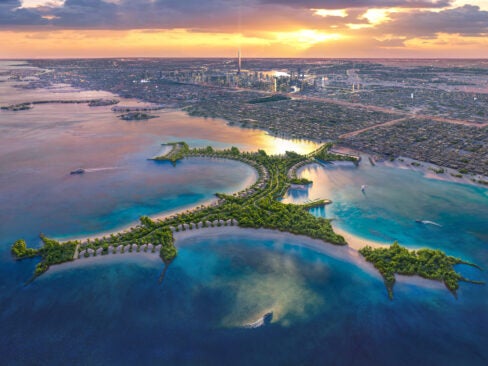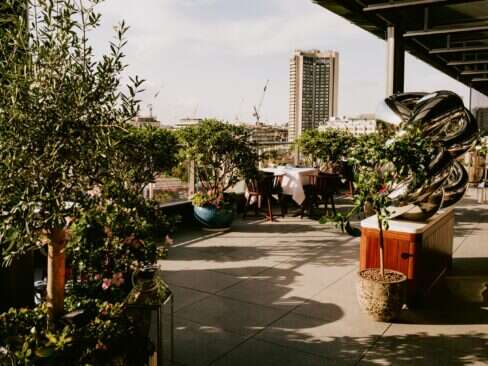Unlike with high-end fashion or farm-to-table dining, the definition of what’s ‘in season’ can be tricky to define in the world of travel. There are places that will always see a steady stream of visitors, no matter the time of year; New York City, London or Paris, for example, see a constant flow of tourists, differentiated only by when each locale has its school holidays. Then there are places that, because of the weather, are natural fits for certain times of year — like the Alps in ski season, and Mexico and the Caribbean in the depths of winter.
With factors like climate change, a greater awareness of overcrowding (especially in a socially distanced world) and sustainable tourism in play, many popular destinations have also made a concerted effort to extend their offerings beyond their typical high seasons, and to remarket themselves by developing new attractions. Some of the best examples of this can be found in the American West, where traditional ski destinations like Aspen, Vail and Park City have — through things like world-class arts programming, hiking and biking trails, and big-name food festivals — made their summers and falls almost as busy as their winters.
With this in mind, there is something extra special, then, about visiting a destination when it’s least expected. To be clear, that doesn’t mean pulling up to somewhere hyper-seasonal like Mykonos or Santorini in January — when most venues are closed and many locals have left for vacations of their own — or checking into a hotel just before it closes for the year, when the staff is winding down after their busiest months and certain facilities may be unavailable. Instead, with just slight adjustments to our expectations, a willingness to veer from the beaten path, and the right pairing of destination and timing, it’s possible to enjoy the best of what a place has to offer without the hassles that come with following the crowds. From better access to coveted reservations, exclusive experiences and special programming (like hotel wellness retreats or food festivals) to the chance to connect with locals and garner insider tips, traveling off-season has its perks.
California
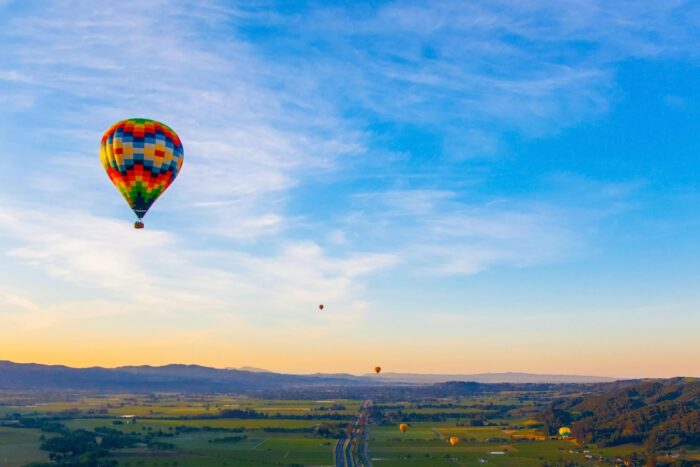
Hot air balloon flights form part of the Napa Lighted Art Festival in Napa Valley
The chance to connect one-on-one with winemakers is a plus of visiting Napa and Sonoma valleys in late fall to early spring. After the fall harvest crowds have gone, the November-to-April shoulder season — or, as it’s known here, Cabernet Sauvignon season, as that’s when the famed vintages are released — brings with it a gorgeous change in scenery, with the dormant vineyards ablaze with bright-yellow wild mustard flowers, purple lupine, crimson clovers and golden California poppies.
This is the time to nab hard-to-get reservations at places like The French Laundry and The Restaurant at Meadowood, and the time when higher-end hotels can arrange for behind-the-scenes tours and special tasting at area wineries. In January, enjoy events like the Napa Truffle Festival and the Napa Lighted Art Festival — the latter a nine-day affair featuring interactive light displays, hot air balloons, art walks and more. Warm up with a dip in one of the area’s geothermal springs or mud baths (resorts like Solage and Calistoga Ranch offer those treatments.) The 2020-2021 low season is also poised to be particularly notable here, as the region is welcoming a slew of high-profile new hotels, including the Four Seasons Napa Valley and Montage Healdsburg.
Italy
One of the top places to experience the magic of the slower months is Italy. While hotels and businesses in tourism-driven coastal areas like the Amalfi Coast, Sardinia and Sicily do, for the most part, close down for a few months in the winter, regions like Veneto, Tuscany and Umbria offer their own charm throughout the year. Minus the cruise ship crowds, the tiny, winding alleys of Venice are particularly atmospheric in the fall and winter — even more so during January’s Carnival, when those alleys are dotted with figures sporting elaborate masks and costumes.
You’re more likely to get to chat with locals over aperitivo and cicchetti in the quieter seasons (many of them flee the crowds and rent out their apartments in the summer), and celebrate with them during local festivals like November’s Festa Della Salute, a citywide event marking the end of the 1630 plague (which will surely take on added significance this year). To best enjoy this event, check in to the five-star Sina Centurion Palace, which is set on the Grand Canal, a short walk from the Guggenheim museum and the Basilica of Santa Maria della Salute, where the festival takes place.
Further south in Florence, visiting in the fall means you’ll still likely enjoy sunny weather, but won’t have to jostle with the crowds inside the Uffizi or the San Lorenzo Market food hall, try to navigate the narrow streets around tour groups, or fight to snag reservations at the Michelin-starred restaurants or hidden-away, art-lined Vasari Corridor. (Another bonus: come fall, you’ll actually start hearing Italian spoken on the streets and trains again, after a summer dominated by English speakers.)
Even better are the activities available in the quieter periods. In Florence, the recently redesigned Rocco Forte Hotel Savoy offers behind-the-scenes tours and premier seating at the opera (whose season typically kicks off in the fall), while the Four Seasons Hotel Firenze can set up private dinners in a 15thcentury palazzo that once housed Leonardo da Vinci, or on the only terrace on the Ponte Vecchio bridge, which would be nearly impossible in the summer.
To connect you to the rest of Tuscany, hotels like Baglioni Relais Santa Croce and Villa La Massa (a sister to Lake Como’s Villa D’Este) have relationships with the Guicciardini Strozzi winery — overseen by two titled princesses — offering guests a day of wine tasting and truffle hunting on the vast grounds, while the COMO Castello Del Nero resort, set on 740 scenic Tuscan acres, takes guests on treks through a local forest led by a licensed truffle hunter and his specially trained dog, followed by lunch at its Michelin-starred La Torre restaurant, located in the original stables of the castle.
Truffle festivals in towns like San Miniato (best known for its white varieties) and San Giovanni d’Asso also happen in late fall; this time of year is also prime for visiting wineries in the region, when it’s more likely you’ll enjoy a tour or tasting led by the winemaker or owner themselves.
Scotland & Ireland
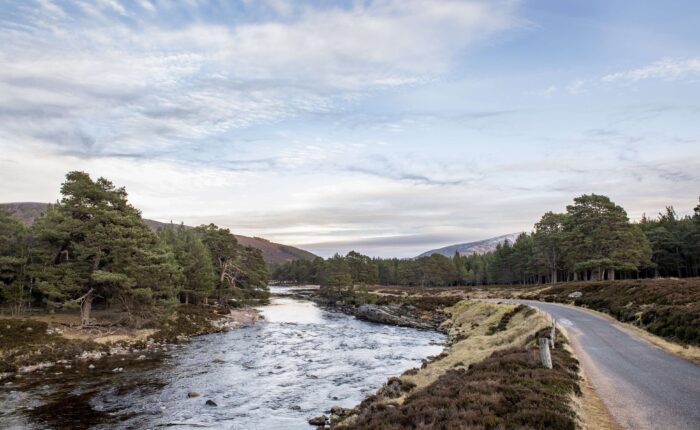
Upper Deeside near the Fife Arms Hotel
Across the Atlantic Ocean, it’s whisky — and golf — that draw travelers to Scotland and Ireland, even in the colder months. In both countries, fall and winter are a better bet for scoring prime tee times (even though the days may be shorter.) In Scotland, play the courses around Aberdeen, where the weather tends to be milder — top picks include the Championship Links at Cruden Bay and challenging Royal Aberdeen, which is said to date back to 1625 — then head to the Highlands to take in the stunning scenery and thrilling adventures. Set in Cairngorms National Park and originally a 19th-century Victorian coaching inn, The Fife Arms hotel is a cozy base from which to enjoy whisky tastings at local distilleries, history tours of nearby castles and landmarks, peaceful nature walks, and winter sports like skiing and snowshoeing.
In Ireland, one of the country’s best courses is also at one of its top hotels. Open year-round except for January and February, the Tom Fazio-designed greens at Adare Manor were, like the hotel itself, overhauled and relaunched in 2018, better than ever. If golf’s not your thing, the cooler months still bring lots of delights, from settling down with a good book around the Great Hall’s fireplace and lingering over the legendary Afternoon Tea (which often sells out in high season) to learning about the exclusive whiskey partnerships in the underground Tack Room bar and savoring meals in the Oak Room, which earned a Michelin star in 2020.
Traditional activities like falconry, horse-drawn carriage rides and forest walks, typically offered at historic hotels like Adare Manor and Dromoland Castle, seem made for colder temperatures, particularly when you can warm up with an Irish coffee afterwards. And surrounding it all is fall foliage that, while not as widespread as in other destinations, is still a panorama of vivid reds, oranges and golds against the emerald landscapes. Before flying out of Dublin, check in to the legendary (and recently redone) Shelbourne Hotel, where you’re more likely to be able to book a top suite, like the elegant, park-view Princess Grace Suite, in the slower season.
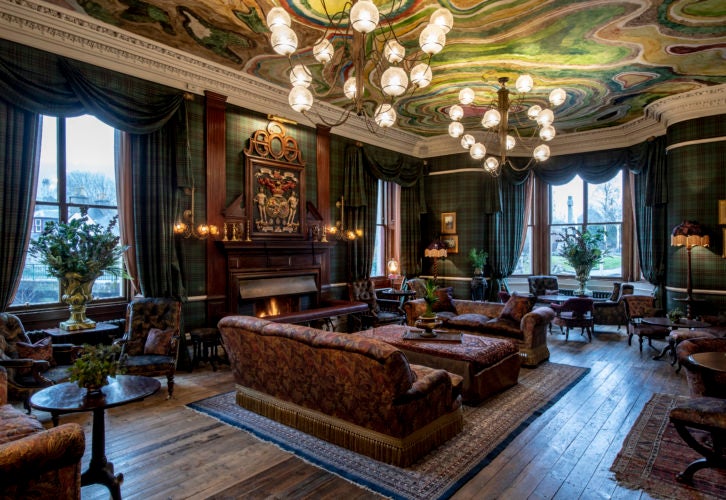
The Drawing Room at The Fife Arms / ©SimCanettyClarke
France
More fairy-tale charm also can be enjoyed in France, where in the southwest Massignac commune, near Limoges, the 2,500- acre Domaine des Etangs private estate is centered on an 11th-century chateau. Settle into a suite in the main chateau, the nearby Longère building, or in one of the farmhouse cottages.
Enjoy dining on seasonal fare at the Michelin-starred restaurant, guided walks of the forest with the groundskeeper, browsing the on-site art gallery and libraries, and family-friendly activities like grooming the resident cows and relaxing in the chateau’s enormous attic game room, where a ‘treasure box’ is filled with dress-up clothes for the youngest guests.
If you’re craving a bit more sunshine, travel down to the Côte d’Azur, which — thanks to its mild temperatures — is nearly always in season. The main difference is that while the number of visitors in summer can grow to an average of 200,000 a day, that drops to around 50,000 per day in still sunny December and January — meaning that you might just have the museums, palaces and outdoor cafes all to yourself, and that the locals will have more time for a chat. With small-town fall festivals happening along the coast, sailboat races in St. Tropez as late as October, and Christmas markets in December, your low-season memories from this destination will extend far beyond the beaches.
New Zealand
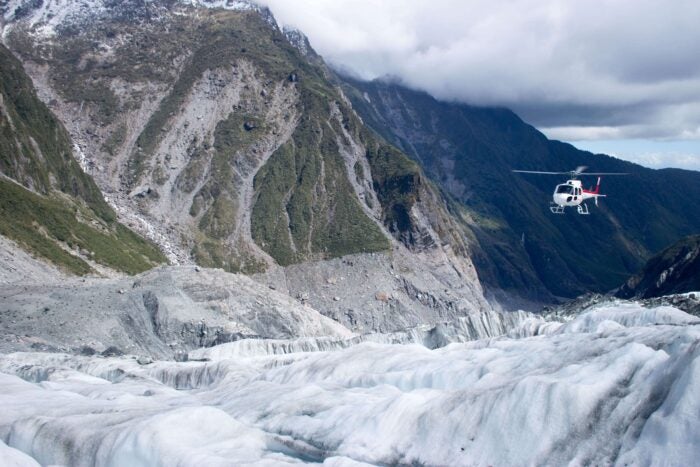
Helicopter flies over the Franz Josef glacier on South Island, New Zealand
On the other side of the world, winter sports can also be enjoyed in New Zealand, where the overall low-season is April to September, as well as June and September in the ski areas. With generally fewer crowds, winter in the southern hemisphere is the perfect time to explore the majestic beauty of the country, and to get the blood pumping on the South Island with world-class skiing and heli-skiing, trekking on the Franz Josef or Fox glaciers, and more.
June and July are also the best months for whale watching, with the opportunity to spot humpback, blue or southern right whales at Kaikoura as they migrate towards the continental shelf. To be close to the action in Queenstown, considered the hub of the South Island’s adventure scene, check in to Matakauri Lodge on the shores of Lake Wakatipu (from which it’s an unforgettable helicopter ride out to Fiordland National Park), the coastal rain forests, the blue glaciers of the Southern Alps and the high-country station at Milford Sound, where you can land at an Alpine lake and hit eco golf balls off a mountain driving range.
Russia
If your idea of a winter wonderland is more the fairy-tale variety, head to St Petersburg. Like Venice, the European-influenced Russian city is a popular cruise port, with an estimated 625,000 passengers disembarking during the Baltic cruise season — which also means, like Venice, the warmer months feel overrun. But while summer may offer the chance to experience the extended daylight hours of the White Nights (the city is not far from the Arctic Circle) and enjoy more outdoor time, there’s something that feels inherently authentic about visiting in the fall and winter — like you’re stepping into the pages of a Russian novel.
Autumn is chilly but pleasant, but from November to March you’re more likely to find frozen canals and rivers, and the iconic dome-topped buildings dusted with snow. This is the time for ice skating at an outdoor rink, troika rides in the countryside, outdoor ice bars, nights at Mariinsky Theater for the opera and ballet, and lively winter festivals — the latter including the street parties celebrating the new year. Add to that crowdless visits to Catherine the Great’s Winter Palace and the art-filled Hermitage, and you’ve got all the makings of a romantic getaway.







